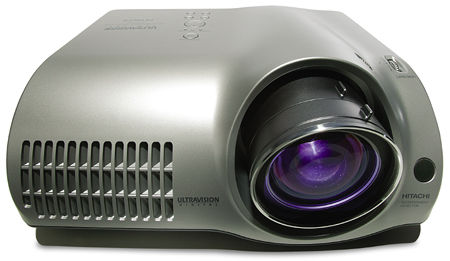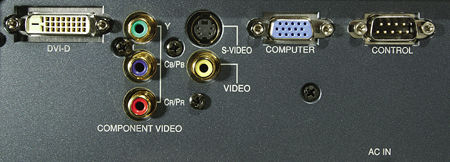Hitachi PJTX100 UltraVision front LCD projector

As quickly as it had appeared, the Home 1 vanished and was replaced by the PJTX100, which I first saw at Hitachi's East Coast line show in late May of 2004. I soon procured a review sample, and it was obvious from the first time I powered it up that this projector was a "night and day" improvement over its predecessor.
Both projectors share the same attractive, curved-face housing, but the PJTX100 has a lot more resolution than the Home 1. Gone are those "quarter-HD" LCD panels—in a step also taken by LCD projector makers Sanyo and Panasonic, Hitachi's PJTX100 has full high-definition 1280x720 imagers. That's good news; as the prices of HD-resolution LCD projectors continue to drop, there's just no sense any more in settling for lower resolution.
But increased resolution isn't the PJTX100's sole appealing feature. Hitachi has thrown in a full range of image and signal adjustments that should satisfy the most hardcore projector tweaker, including a 10-step variable lens iris for improving black levels, three preset iris positions, a wide range of gamma adjustments, and preset and custom white balance adjustments.
Out of the Box
The PJTX100 is one of a growing number of projectors that reject the cereal-box designs so common to lower-priced front LCD and DLP projectors; instead, they emulate the fancy housings adopted by SIM2. (Samsung's long-delayed front DLP projector has a similar appearance.) In contrast to its squared-off rear panel, the Hitachi's front slopes down gracefully, leaving only the protruding lens assembly.
The lens is adjusted manually and has a nice 1.6:1 maximum zoom ratio, which should provide a great deal of flexibility in projector and screen placement. Hitachi also includes horizontal and vertical lens shift to overcome any keystone problems from off-center projection.
There are a minimum of controls on the top of the projector, which leads me to think that Hitachi intends it to be permanently installed, and not merely pulled out of the closet and set up when needed. You'll spend more time using the remote anyway; it's simple in layout and easy to use.
For connections, Hitachi has included the basics: a DVI-D interface for handling component-video and computer signals, a three-RCA Y-Pb-Pr wideband component input, another RCA jack for composite video, a DIN jack for S-video, and a 15-pin D-sub VGA jack for computers or set-top receivers. That's about all anyone should need in a typical installation without using an external video switcher. The only other connector is the standard 9-pin RS-232C control interface.
Remote and Menus
I've tested hundreds of business and home theater projectors over the years. One thing that always drives me crazy is a remote control that has too many buttons, is hard to read in dim light, uses a mousedisc for menu navigation, or has buttons so tiny that even a mouse would have trouble operating them.

The PJTX100's remote has none of these failings. It sports one of the simplest layouts I've seen, with a minimum of buttons, and the buttons themselves are large, backlit, and quite tactile. I could find my way around it in the dark quite easily. It provides direct access to any input, as well as to brightness, contrast, and color adjustments, five aspect ratios, and the variable iris settings for enhanced black levels.
The menu itself is easy to read and quickly navigated. In addition to the basic image-adjustment functions, you have access to four preset Gamma curves and six White Balance settings, from Dynamic (with no color correction) to D6500. You can also enter a custom Gamma menu that provides tweaks at eight different luminance levels and three different gray-scale ramp test patterns to help with those tweaks.
White Balance can also be fine-tuned from the menu. Adjustments of RGB offset and gain are represented graphically by a series of vertical sliders. As you toggle between each of the preset White Balance values, you can watch as the RGB sliders move to different positions. Those positions are all expressed numerically, so you can jot down your settings for future reference.
The PJTX100 is supposed to select the correct color space automatically, but just in case you don't trust it to do so, the menu lets you choose from RGB, SMPTE 240, REC709, and REC601 color spaces. (If you don't know what these terms mean or what their color-coordinate values should be, leave the projector in Auto mode and let it do the work for you.)
I mentioned earlier that the DVI input (which is HDCP-compatible) also accepts signals from a computer. To do that, you'll need to go into the menu and manually select PC mode for this input. The component-video choice is marked DVD, but it will also handle set-top receivers just fine.
The 10-step iris function acts like a variable f-stop function on a camera lens. Light levels are gradually reduced, with the intent of dropping the level of black lower and lower. There are also three iris presets accessible from the remote control: Natural Black, Deep Black, and Off (iris wide open).
You can set the PJTX100 to operate with less fan noise by selecting its Whisper mode. This drops the lamp brightness by about 11%, and the cooling fan runs at a lower speed. I didn't find the fan to be particularly loud unless I was sitting or standing close to the unit. In a permanent installation, you probably won't notice it at all.
Other bells and whistles include digital keystone correction (avoid this and use the mechanical lens shift) and a screen-capture function that lets you save any image on the screen as a bitmap that will display when you first turn on the projector, or when no signal is detected on an input. In short, you have access to all of the functions you'd want to get the best image quality out of the PJTX100.
Picture Quality
After I set the controls to obtain the best image quality (see "Calibration" sidebar), I started playing DVDs, including Pirates of the Caribbean: The Curse of the Black Pearl, Video Essentials, and The Matrix, plus off-air HDTV from a local broadcast of HDNet (1080i) and a D-VHS tape of Game 5 of the 2004 NBA Finals (720p). I checked each DVD in 480i and 480p modes through my Panasonic RP56 player, and in DVI mode through the V, Inc. Bravo D1 player.
Color quality was excellent for an LCD projector, holding its own against the Panasonic PT-AE500U (reviewed in the June 2004 UAV). Flesh tones and pastel colors are difficult for any LCD projector to reproduce, but the L.A. Lakers' purple-and-gold uniforms were a close match to those seen on my Princeton AF3.0HD reference monitor. Only the high black levels reduced color saturation in areas of low picture brightness.
Pirates has forcibly retired The Fifth Element as my preferred disc for testing a projector's dynamic range, and its saturated red, white, and blue British uniforms—plus all that gold and silver booty—are good tests of color accuracy. As you might expect, the picture detail and color saturation of the daytime scenes held up exceptionally well.
The nighttime scenes in the pirates' cave and the looting-and-pillaging sequence needed a lot of help rendering shadow detail—no combination of Iris and Gamma settings could solve that problem. Switching to The Matrix confirmed this impression. The fight in the subway station was plagued by a loss of detail, but the outdoor fight scenes were crisp and detailed.
I question how many UAV readers these days actually use the composite inputs on any HT display. If you do, the PJTX100's internal composite-video decoder is either a simple notch or a weak comb filter. It dropped a lot of picture detail above 300 lines, and I saw plenty of cross-color and cross-luminance moiré.
 The projector did pick up transitions quickly from 30fps video to 3:2 film-to-video transfers, but its 3:2 motion wasn't always smooth. The waving flag sequence from Video Essentials appeared cleanly, with some visible interlaced-scan line artifacts, but my Panasonic RP56 does a better job in this regard.
The projector did pick up transitions quickly from 30fps video to 3:2 film-to-video transfers, but its 3:2 motion wasn't always smooth. The waving flag sequence from Video Essentials appeared cleanly, with some visible interlaced-scan line artifacts, but my Panasonic RP56 does a better job in this regard.
Another limitation of LCD projectors is the "screen-door effect." This appearance of dividers around the individual LCD pixels is something you'll certainly see if you like to sit close to your projection screen. To overcome this problem, I suggest using the standard 3:1 ratio of seating distance to screen height. In my tests, I sat about 12 feet away from an 80-inch-wide Da-Lite screen, and the pixels weren't evident at all—only those murky low gray levels.
HDNet program material, carried on local DTV station WFMZ-46, varied considerably in quality. Such programs as The Mark Cuban Show or The Dallas Mavericks Cheerleaders Calendar Photo Shoot (now there's a mouthful) had great sharpness and color quality. The cheerleaders' blue uniform colors really popped off the screen, and flesh tones were as good as the best single-chip front DLP projectors I've tested.
Sports sequences, such as downhill bike and go-kart racing, weren't as impressive due to the preponderance of MPEG blocking artifacts and mosquito noise in HDNet's signal, so don't blame the projector for that. You won't notice this garbage as easily on a smaller (26–34 inches) HDTV, but it really jumped off the screen when projected by the PJTX100. Still, color quality was excellent, and such subtle pastel shades as pale yellows and greens looked very close to what I saw on my Princeton monitor.
Conclusion
I'm beginning to think that LCD projector manufacturers are fast reaching the end of the curve with respect to image quality. While everything that can be done has been done to make the Hitachi PJTX100's projected images look as good as they possibly can, high black levels remain an insurmountable wall.
Solutions such as Hitachi's variable iris create the perception that black levels are lower, but once shadow detail from any electronic image is lost, no amount of lens trickery can recover it. A gray screen (which I do not use in my tests) might help a little with making the projector's muddied blacks look deeper.
Still, Hitachi has done an excellent job with the PJTX100. It has every control and adjustment I'd expect or want in a home theater projector, and with patience, some really great video can be coaxed out of it. You'll be pleased with its picture detail and color quality, particularly if you feed the PJTX100 a steady diet of 480p movies and hi-def programming. An outboard video scaler can help with lower-resolution composite sources; e.g., cable movie channels.
With a list price of just under $4000 and the usual aggressive discounting of LCD projectors, the PJTX100 is slightly more costly than Sony's VPL-HS20U ($3499). But Panasonic's PT-AE500U delivers comparable performance for $1500 less and may be the better buy, despite the fact that it's only 71% as bright and has slightly lower contrast numbers.
- Log in or register to post comments






























































